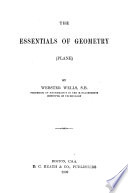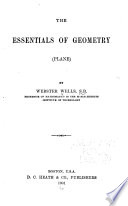 In any proportion the terms are in proportion by division; that is, the difference of the first two terms is to the second term as the difference of the last two terms is to the fourth. In any proportion the terms are in proportion by division; that is, the difference of the first two terms is to the second term as the difference of the last two terms is to the fourth.  Solid Geometry - Page 254by John H. Williams, Kenneth P. Williams - 1916 - 162 pagesFull view Solid Geometry - Page 254by John H. Williams, Kenneth P. Williams - 1916 - 162 pagesFull view - About this book
 | George P. Lilley - Algebra - 1894 - 522 pages
...Subtract 1 from each member, a—bc~ d or ~T~ = ~d~ " VII. If four numbers are in proportion, they will be in proportion by division ; that is, the difference of the first two will be to the second as the difference of the last two is to the fowth. Hence, VIII. If four numbers... | |
 | George Albert Wentworth - Mathematics - 1896 - 68 pages
...sum of the last two terms to the fourth term. 301. If four quantities are in proportion, they will be in proportion by division; that is, the difference of the first two terms will be to the second term as the difference of the last two terms to the fourth term. 302. In any... | |
 | Webster Wells - Algebra - 1897 - 386 pages
...Or, a(c + d) = c(a + b). Whence, a + b: a = c + d:c. (§ 309! In like manner, we may prove that 313. In any proportion, the terms are in proportion by...is, the difference of the first two terms is to the first term as the difference of the last two terms is to the third term. Let the proportion be a :... | |
 | Webster Wells - Algebra - 1897 - 422 pages
...equation to ac, ac + ad = ac + bс. Or, а(c + d) = c(a + b). Whence, a + b: a = с + d: c, (§ 309) 313. In any proportion, the terms are in proportion by...is, the difference of the first two terms is to the first term ax the difference of the last two terms is to the third term. Let the proportion be a :... | |
 | Webster Wells - Algebra - 1897 - 522 pages
...d} = c(a + b). Whence, , _ a + b : a — c + d: c. (§ 309) In like manner, we may prove that 313. In any proportion, the terms are in proportion by Division; that is, the difference of the ./īrst two terms is to the first term as the difference of the last two terms is to the third term.... | |
 | Webster Wells - Geometry - 1898 - 264 pages
...ad = ac + be. Factoring, a(c + d) = c(a + 6). .-. a + b:a=c + d:c. (§ 234) PROP. VI. THEOREM. 238. In any proportion, the terms are in proportion by...is, the difference of the first two terms is to the first term as the difference of the last two terms is to the third term. Given the proportion a:b =... | |
 | Webster Wells - Geometry - 1898 - 284 pages
...+ b). .: a + b : a = c + d : c. (§ 234) In like manner, a + b:b = c + d:d. PROP. VI. THEOREM. 238. In any proportion, the terms are in proportion by...DIVISION ; that is, the difference of the first two term* is to the first term as the difference of the last two terms is to the third term. Given the... | |
 | James Howard Gore - Geometry - 1898 - 232 pages
...Therefore (by 201), a + b: a:: c + d: e. PROPOSITION VI. 205. If four quantities are in proportion, they are in proportion by Division; that is, the difference of the first and second is to the first as the difference of the third and fourth is to the third. Let a : 6 = c... | |
 | Webster Wells - Geometry - 1899 - 424 pages
...ad = ac + be. Factoring, a(c + d) = c(a + b). .: a + b:a=c + d:c. (§ 234) PROP. VI. THEOREM. 238. In any proportion, the terms are in proportion by...is, the difference of the first two terms is to the first term as the difference of the last two terms is to the third term. Given the proportion a : b... | |
 | Webster Wells - Geometry - 1899 - 450 pages
...= ac + bc. Factoring, a(c + d) = c(a + b). .-. a + b:a = c + d:c. (§ 234) PROP. VI. THEOREM. 238. In any proportion, the terms are in proportion by...is, the difference of the first two terms is to the first term as the difference of the last two terms is to the third term. Given the proportion a:b =... | |
| |